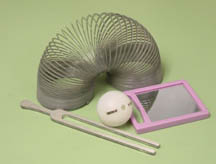BACKGROUND:
Waves are a means by
which energy travels. Many different particles move in waves. The waves
on an ocean are physical waves caused mainly by wind. Light is an
electromagnetic wave caused by excited electrons. The movement of a wave
is complicated, but both electromagnetic and physical waves use similar
ways to describe the motion.
Both electromagnetic and physical waves
reflect, refract and diffract energy. These properties of wave motion
are important because they explain how waves move. Waves (both physical
and electromagnetic) if controlled, can produce products we use in our
society. The phone, television, radio, microwaves, CD players, lasers,
video players and many other items are products produced by
understanding these waves. The details in these lessons emphasize the
importance of understanding waves.
Diffraction is when a
wave goes through a small hole and has a flared out geometric shadow of
the slit. Diffraction is a characteristic of waves of all types. We can
hear around a corner because of the diffraction of sound waves. For
instance, if a wall is next to you when you yell, the sound will
parallel the wall. The wall may stop, but the voice doesn't; sound will
almost turn the corner of the wall. This is diffraction.
Reflection is when waves, whether
physical or electromagnetic, bounce from a surface back toward the
source. A mirror reflects the image of the observer.
Refraction is when waves, whether
physical or electromagnetic, are deflected when the waves go through a
substance. The wave generally changes the angle of its general
direction.

PROCEDURE:
In this lab, students determine which
situation illustrates diffraction, reflection, and refraction. Discuss
the main definition of each term. Have students go to the different
stations, perform the activity, and decide which motion the waves are
producing. Some of materials shown in picture below.
The following will help in setting up
stations.
- Fill a clear glass partially with
water and put a pencil or other type of rod in it. Instruct students to
look at the side. The students will see an off-centered pencil. The
light is being refracted by the water, so our eyes see the pencil in two
different mediums. Answer: electromagnetic (light); refraction
- Make 3 sets of slits with a razor
in a sheet of aluminum foil (like diagram). Put the laser in a darkened
corner with a box on the top (so students won't stare at the light).
Instruct students to put each of the slits in front of the light and
record what they see. The light will get elongated which illustrates
that the light is actually diffracted or "flaring outward."
Where the slits are double, the light will have bright and dark areas.
This is called interference. Do not expect students to know what
actually causes this. Answer: electromagnetic (light); diffraction

- Instruct students to hit the tines
of a tuning fork (in kit) and place the tines on the surface of the water. Waves
will move from the center of vibration. Notice that the pattern spreads
from the center and causes little ripples. This shows not only
diffraction but also interference similar to that in station 2. Answer:
physical wave; diffraction
- Using a spoon, instruct students to hit the
surface of the water in a pan of water. The ripples should be
large enough to hit the end of the pie tin and reflect backwards.
However, students might only see the spreading outward and call
this diffraction. Answer: physical wave, reflection and/or
diffraction (students should justify answer)
- Instruct two students extend the
slinky in a straight line about 1 meter. One student should push back
several of the coils and then release them. The waves will go down the
slinky and reflect from the other end and bounce back. Answer: Physical
wave, reflection.
- Instruct two students to extend
the rope. One should snap their wrist to create an oscillating wave. The
wave reflects backwards when it hits the other student. Answer: physical
wave, reflection
- Instruct students to shine a small
beam of light through a prism (in kit). If the light is angled correctly, they
should get a rainbow effect. Also, put the prism on the laser light.
(This shows the refraction better). Answer: electromagnetic (light);
refraction
- Instruct students to shine a light
on a mirror (in kit). (Students may also try the laser light). The light bounces
off. Answer: electromagnetic (light); reflection
- If a beam of light is shone
through a lens, the light will refract through the lens and create a
different size image on the other side. Answer: electromagnetic (light);
refraction
- The energy ball (in kit) will make a sound
and cause light to flash when you use your fingers to complete the
circuit. Answer: both physical (sound) and electromagnetic (light);
diffraction of light and sound
|